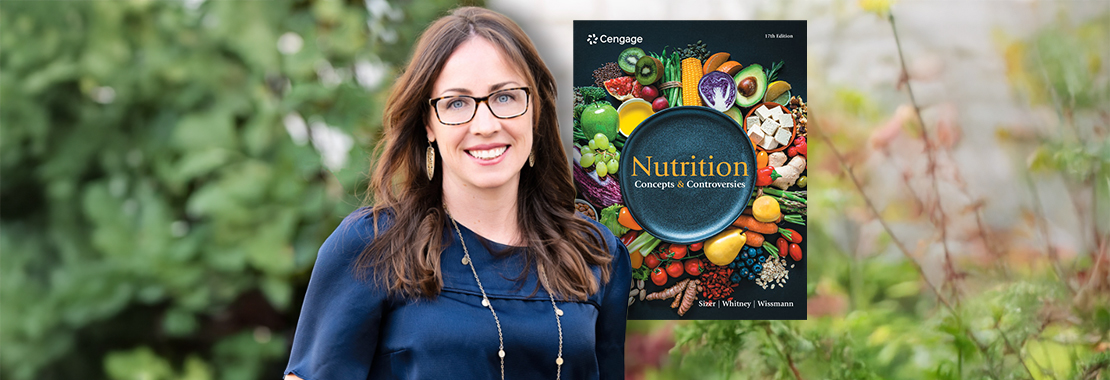As an educator and advocate for evidence-based nutrition, I’m thrilled to introduce both the 17th edition of the best-selling text, “Nutrition: Concepts & Controversies,” and myself as its newest author. This edition marks a pivotal shift in how we teach, learn and live nutrition — not just as a science, but as a lifelong journey toward wellness.
A little about me: My background in nutrition education
My name is Mary Wissmann and I am an Adjunct Faculty Instructor of Nutrition and Exercise Physiology at University of Missouri. My husband and I are both University of Missouri alums. We have three of our own future Tigers ranging in age from high school to elementary school. After completing my dietetics training and receiving my master’s degree in nutrition at Mizzou, I began working in my local county for the University of Missouri Extension as a regional nutrition specialist. Teaching community education classes for many years really emphasized gaps in general nutrition knowledge in the larger community.
Teaching nutrition for everyday life: My classroom philosophy
My teaching philosophy is based on bringing material from the text into students’ everyday lives. One of my favorite assignments each semester is a student writing assignment on nutrition and health misinformation. Students search their social media feeds, news reports and podcasts for attention-grabbing headlines about nutrition and health. This activity inspires a deep dive into nutrition and health misinformation. Students use the techniques learned in the text to support or refute the ideas presented online. They learn about credible sources and practice using those sources to answer their own questions on the topic.
In addition to applying information online, I also encourage my students to apply what they learn in the kitchen. Nutritional knowledge is valuable but has little impact on health if it isn’t relevant to a person’s eating habits. After introducing each of the macronutrients, students prepare an associated recipe that highlights a classic, yet simple cooking technique. By the end of the semester, students are much more confident and adept at planning and preparing their own meals that illustrate the concepts learned throughout the semester.
New updates to this 17th edition
The following are a few of the more significant updates we’ve made to this new edition for an overall better student learning experience.
An evidence-based approach: Health is not one-size-fits-all
One of the most transformative updates to this edition is our weight-neutral approach to health. We’ve moved away from the outdated notion that health is synonymous with body size. Instead, we focus on incremental, sustainable behavior change. This fosters long-term well-being, regardless of weight. It’s a perspective that encourages students to embrace health as a personal, evolving pursuit — not a one-size-fits-all destination.
Not only does this updated version includes the latest data, statistics and cutting-edge research about health in the U.S. and across the globe, but it also includes important updates to the language we use around bodies and health. This text removes the focus on body weight and size as the ultimate indicator of health and instead directs students’ attention to the actionable behaviors that lead to an end-goal of longevity and good health.
Notable changes to Chapter 9
Major changes are noticeable to the organization and language of Chapter 9, which is now called “Energy Balance and a Healthy Body.” It includes a discussion about the challenges of the body mass index tool, an inclusion of intuitive eating principles and the benefits of physical activity independent of body weight. Nearly every chapter identifies the detrimental impacts of diet culture and refocuses the information around a weight-neutral approach to health.
Science you can see: Measured references and new tables
Nutrition is a data-driven science, and we’ve made sure students can see that clearly. The 17th edition features updated figures and calculations that reflect the latest U.S. health and nutrition data, from chronic disease trends to economic influences on food choices. Our new and revised tables distill complex information into visual formats that support comprehension and retention, especially for visual learners.
Cutting through complex topics
This text will help students understand nuances around complex nutrition and health issues and correctly interpret nutrition research. Its content will help students sift through the onslaught of mis- and disinformation that they will encounter in this digital age of information. Throughout the text, current trends in diet and wellness culture are highlighted to bring relevance to students’ daily lives.
The student takeaways
I’m truly honored to contribute to this classic textbook. Students will leave their course with a deeper understanding about how nutrition science applies to their own lives. I hope to spark each student’s interest in nutrition and leave them better equipped to feed themselves today and in the future.
Written by Mary Wissmann, MS, RDN, LD, Adjunct Faculty Instructor at University of Missouri.
Get to know Mary Wissmann and this new edition by watching the video below:



